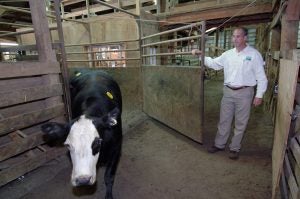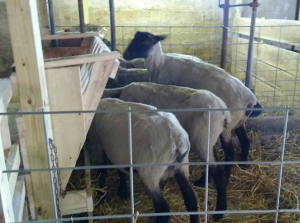Where do livestock go when they’re market ready? It’s a question I get asked often, and the answer is: It varies.
First, let’s talk about larger-scale commercial production. In the world of pig farming, for example, a majority of farmers contract to raise livestock for a specific company. A farmer might raise X amount of pigs per year, where they “contract grow” for a certain brand like Hormel or Smithfield. Basically this means that they sign a contract saying they’ll work with them specifically and produce so much pork per year, oftentimes for multiple years.
Poultry is a lot like this as well. Large chicken farmers contract to produce poultry for corporations (known as an “integrator”) like Tyson, Perdue, or Pilgrims Pride. Eggs and turkey would have similar circumstances. Learn all about this process here.

Beef and lamb production, however, are much different — farmers and ranchers don’t always know where their livestock end up after it’s time to go to market. They can work with one buyer directly, but it’s not as common as it is in poultry or pork.
For small- and mid-scale farmers, it is indeed generally quite different. When I was on the cattle farm, we raised a couple of hundred head of beef cattle per year and sold them at farmers markets and to friends and family, where we would take them in to our local U.S. Department of Agriculture inspected butcher. Most of our cattle, however, went to our local “sale barn” on Wednesday nights for auction the following day. We always sorted out the top end — the fattest and best ones — first for the sale. Our trailer held six head of cattle, and during the busy season, we would usually take in two to three trailer loads each of those Wednesday evenings.
The following morning, the buyers would show up, usually with big tractor-trailer rigs. They’d bid on cattle to fill their trailer and then take them to the meat packers and processors. They might buy six or more from us, as well as cattle from other groups of farms and haul them off to market. These are “middle man” type buyers, who play an important role in transport and processing to ensure we all get enough to eat!

Lamb is similar. For us, we dealt with a local buyer, who was also like one of the the guys you’d see at the sale barn. But we sold almost all of our lambs to him because the families had done business together for decades, and that long-term partnership and trusting relationship was important. So hey, whatever works. You can go with one buyer or go to auction and see if someone offers you a better price. It always varies, and market price for livestock commodities pretty much changes daily.
Then of course, there smaller-scale farms that sell direct. You gotta love your local farmers markets! The challenge with this is that it can be hard to find processors. Depending on region, farmers may be limited to how far away their local USDA butcher is and how strict regulations are. In Iowa, for example, I had to hold many licenses and certifications, and all meat had to be USDA inspected with the Iowa state food safety stamp of approval on it. In Florida, on the other hand, you don’t necessarily have to do that … the meat just has a label that says, “not for human consumption” to protect themselves against unnecessary lawsuits. The meat is still safe and inspected by the butcher, it’s just different wording and regulations in different regions. Regardless, there’s a very great chance that product the farmer is selling is safe and good, just different explanations or regulations.
So without diving in too deep, those are the four basic ways that livestock go from farm to fork — consider it your Cliffs Notes version. The full explanation is much more extensive, because that involves the processors, distribution warehouse, grocers, and so many others!
Whether it’s a small and local farm, a commercial contract grower for an integrator (big corporation), or somewhere in the middle like auctions and buyer/seller relationship, all different types of farms come in all shapes and sizes and have an important role to play in keeping everyone fed.
Michelle Miller, the Farm Babe, is a farmer, public speaker and writer who has worked for years with row crops, beef cattle, and sheep. She believes education is key in bridging the gap between farmers and consumers.



